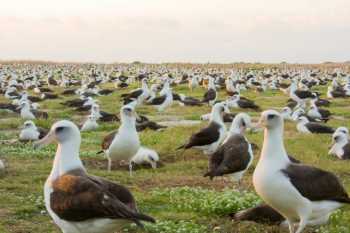The paper's abstract follows:
"Here we report the first measurements of polybrominated diphenyl ethers (PBDE-47, -99, and -153) alongside 11 organochlorine pesticides (OCPs) and 28 polychlorinated biphenyls (PCBs) in the plasma of albatross from breeding colonies distributed across a large spatial east-west gradient in the North Pacific Ocean. North Pacific albatross are wide-ranging, top-level consumers that forage in pelagic regions of the North Pacific Ocean, making them an ideal sentinel species for detection and distribution of marine contaminants. Our work on contaminant burdens in albatross tissue provides information on transport of persistent organic pollutants (POPs) to the remote North Pacific and serves as a proxy for regional environmental quality. We sampled Black-footed (Phoebastria nigripes; n = 20) and Laysan albatross (Phoebastria immutabilis; n = 19) nesting on Tern Island, Hawaii, USA, and Laysan albatross (n = 16) nesting on Guadalupe Island, Mexico. Our results indicate that North Pacific albatross are highly exposed to both PCBs and OCPs with levels ranging from 8.8 to 86.9 ng/ml wet weight and 7.4 to 162.3 ng/ml wet weight, respectively. A strong significant gradient between Laysan albatross breeding in the Eastern Pacific having approximately 1.5 fold and 2.5 fold higher levels for PCBs and OCPs, respectively, compared to those from the Central Pacific. Interspecies levels of contaminants within the same breeding site also showed high variation with Tern Black-footed albatross having approximately three fold higher levels of both PCBs and OCPs than Tern Laysan albatross. Surprisingly, while PBDEs are known to travel long distances and bioaccumulate in wildlife of high trophic status, we detected these three PBDE congeners only at trace levels ranging from not detectable (ND) to 0.74 ng/ml wet weight in these albatross."
Reference:
Suhash Harwani, S. Henry, R.W., Rhee, A., Kappes, M.A., Croll, D.A., Petreas, M. & Park, J.-S. 2011. Legacy and contemporary persistent organic pollutants in North Pacific albatross. Environmental Toxicology and Chemistry. DOI: 10.1002/etc.664.

John Cooper, ACAP Information Officer, 17 September 2011

 English
English  Français
Français  Español
Español